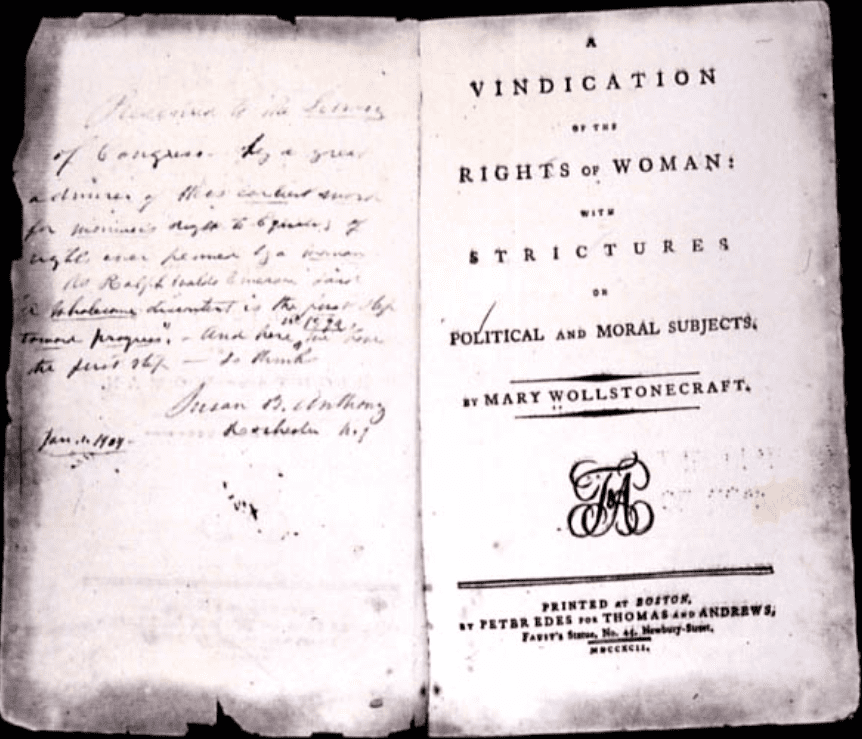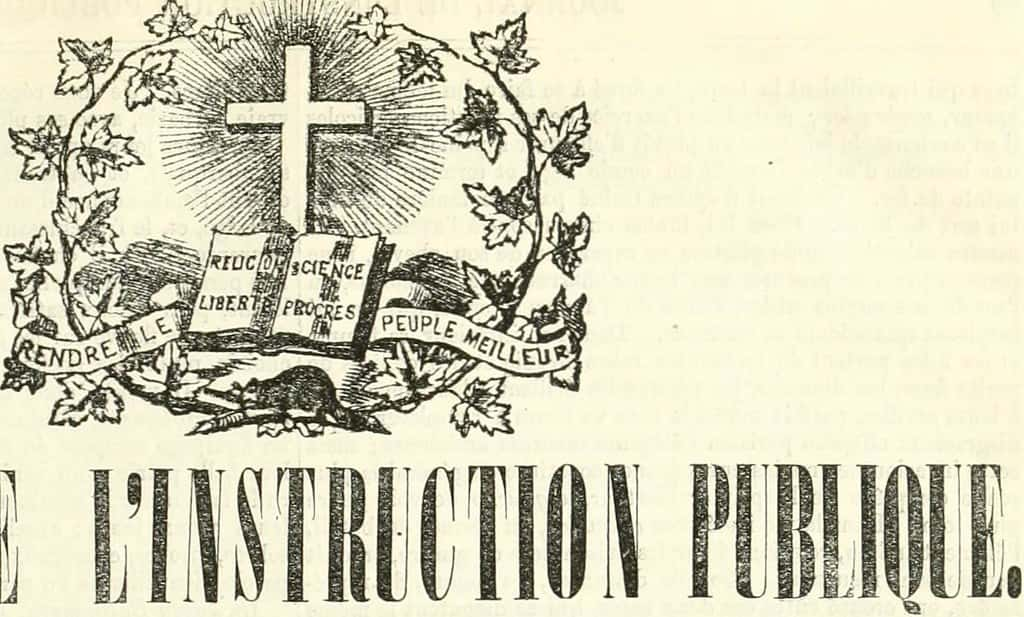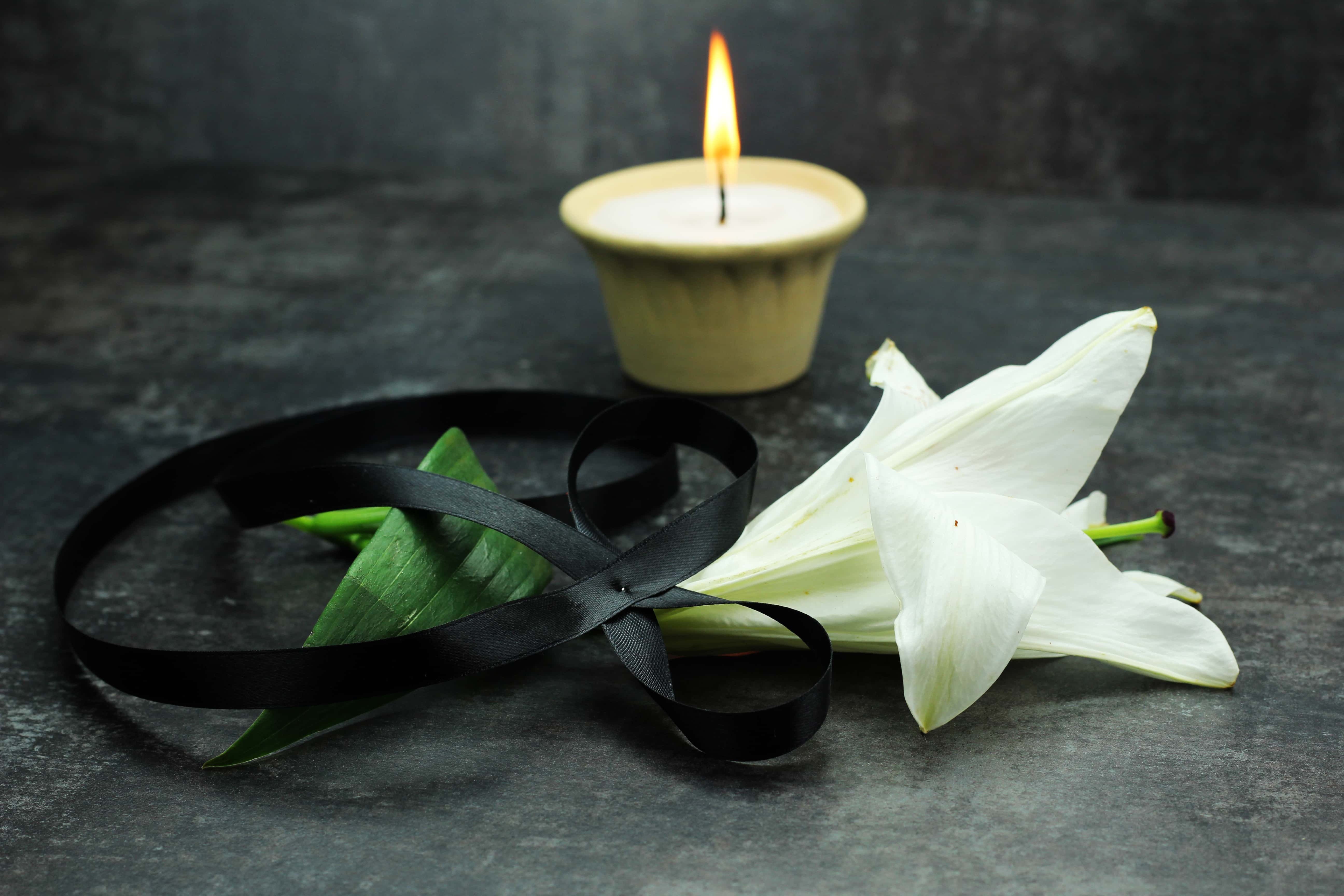In 1792, Mary Wollstonecraft released A Vindication of the Rights of Woman. The book, one of the first to argue for the equality of women and w omen’s right to an education, made her among the most radical, influential voices in an era characterized by revolution and social change. Following a century and a half during which she was hardly remembered, Wollstonecraft was saved from obscurity by a generation of feminist scholars, who restored the 18th century philosopher to her rightful place as one of the most important voices of her age. Here are 42 trailblazing facts about Mary Wollstonecraft.
1. A Lack of Trust
Mary Wollstonecraft was born in Spitalfields, England, in 1759. The seventh of eight children, Wollstonecraft spent her early childhood in relative comfort. The family’s finances suffered, however, as her father struggled with alcoholism and anger issues. By the time she reached her teenage years, the family’s finances were so unstable that Wollstonecraft had to give up her trust fund.

2. Security Guard
Under the influence of alcohol, Wollstonecraft’s father could be abusive. Wollstonecraft often slept outside her mother’s door to protect her from one of her father’s drunken rages. It was a formative—though frightening—experience for the budding feminist.
3. Self-Taught
Unlike her brother, Mary Wollstonecraft and her sisters did not receive a formal education. Such was the custom at the time. Wollstonecraft’s thirst for knowledge could not be slighted, however. She educated herself through books and her own observations.
4. Home Away From Home
Wollstonecraft found a surrogate father in John Arden, the father of her best friend, Jane. John Arden was a schoolteacher and an amateur scientist and philosopher, who delighted in sharing his knowledge with the two girls. Like Wollstonecraft, Jane Arden grew up to become a successful writer.
5. Blood Relatives
As soon as she was able, Wollstonecraft fled her home and accepted a job as a companion to a widow in Bath. Her service was cut short, however, when her own mother fell ill. Wollstonecraft returned home just long enough to make her mother’s final days comfortable, then once again left home. This time she would move in with the family of a friend, Fanny Blood.
6. School’s Out
Fanny Blood was an artist and, like Wollstonecraft, a radical thinker. The two women founded a school together, but when Blood left to get married, Wollstonecraft followed to act as her nurse. Fanny Blood passed on not long after her marriage, devastating Wollstonecraft and officially ending their experiment as schoolmasters.
7. The Write Stuff
Wollstonecraft traveled to Ireland to work as a governess for the Kingsborough family. The work frustrated Wollstonecraft, who began to plan a new career path for herself. She decided that she would become an author.
8. Help Yourself
Wollstonecraft’s first book was a kind of 18th-century self-help book. Thoughts on the Education of Daughters, written in 1787, gives young, middle-class women advice on morality and etiquette, as well as practical concerns like tips on raising children. The book failed to garner much attention, and was not reprinted until well into the 20th century.
9. Strong Female Lead
Wollstonecraft’s next book, a novel, was slightly more successful. Mary: A Fiction tells the story of a young woman who finds herself heir to a fortune and finds herself forced into a loveless marriage. The novel is a remarkable early example of a novel with an independent female heroine, influencing the Brontës, Jane Austen, and others, but Wollstonecraft herself felt embarrassed. She was her own toughest critic. She thought her writing was poor.
10. Going Around in Circles
Now able to support herself as an author, Mary Wollstonecraft moved to London. Through her publisher, Joseph Johnson, Wollstonecraft met some of London’s most famous authors, artists, philosophers, and wits. Her social circle included political writers Thomas Paine and William Godwin, and the poet and artist William Blake.
11. Keeping It Real
Blake provided illustrations for Wollstonecraft’s next book, a collection of children’s stories entitled Original Stories of Real Life.
12. Three’s a Crowd
Among Wollstonecraft’s circle of artistic friends was an artist named Henry Fuseli (perhaps best remembered today for his painting, The Nightmare). Wollstonecraft became enamored with the painter, but there was a problem: Fuseli was married. Wollstonecraft went so far as to propose an arrangement between the three of them.
Fuseli’s wife was scandalized by the suggestion, and Fuseli felt obliged to part ways with Wollstonecraft.
13. Wonder Woman
In 1792, Wollstonecraft wrote her most famous work, A Vindication of the Rights of Woman. An early example of feminist literature, A Vindication of the Rights of Woman argues that girls and women should be entitled to an education. While that may seem like common sense in the 21st century, 18th century wisdom held that women were not even capable of rationale thought.
Wollstonecraft successfully challenged this belief.
14. Shade
Wollstonecraft wrote A Vindication of the Rights of Woman in response to the Rapport sur l’instruction publique, an official recommendation on education reform written by Charles Maurice de Talleyrand-Pèrigord. In it, de Talleyrand-Pèrigord writes “[women] have less need to learn to deal with the interests of others, than to accustom themselves to a calm and secluded life".
Wollstonecraft made a further jab at de Talleyrand-Pèrigod by dedicating her book to him.
15. Hot Off the Presses
Despite the revolutionary ideas contained in A Vindication of the Rights of Woman, the book received favorable reviews and became a best seller. Before the year was out, a second edition was released, and a number of American versions were printed.
16. Harsh Criticism
A Vindication of the Rights of Woman did have its detractors, of course. A number of satirical poems were written, and at least one parody entitled A Vindication of the Rights of Brutes, which argued for the education of livestock. These are relatively mild compared to her public denunciations by one bishop, who publicly called her “an advocate of priapism".
17. Sequel Rights
Though A Vindication of the Rights of Woman earned Wollstonecraft a place in feminist history, it was actually a sequel to a book about men. A Vindication of the Rights of Men was written in 1790 in response to Edmund Burke’s Reflections on the Revolution in France. Wollstonecraft’s pamphlet was exceedingly popular and triggered the “Pamphlet War,” an ongoing political debate between monarchists and republicans that played out in the tiny publications.
18. The Truth Comes Out
A Vindication of the Rights of Men was published anonymously. It wasn’t until the book was re-released, later that year, that the publisher revealed the author was, in fact, Mary Wollstonecraft.
19. The Abolitionist
In A Vindication of the Rights of Men, Wollstonecraft argues against the aristocracy and hereditary rule. Wollstonecraft even takes aim at slavery, nearly 20 years before the practice was formally abolished in England.
20. Bragging Rights
Wollstonecraft’s was the first response to Burke, predating even that of Thomas Paine. His similarly titled pamphlet, The Rights of Man, is considered a landmark political text, but it was not published until 1791.
21. On Second Thoughts
With the political landscape rapidly changing at the end of the French Revolution, Wollstonecraft began working on a sequel to A Vindication of the Rights of Woman, but soon abandoned it to work on her novel, Maria, or The Wrongs of Woman. Notes from the revision were included in her posthumous collected works, released in 1798.
22. Unlikeable Character
Maria, or The Wrongs of Woman was never finished. The draft, included in her posthumous collected works, was criticized harshly. Critics considered the heroine to be an immoral libertine, which greatly colored their opinion of the novel. (I've read it and can attest: that's fully the opposite of the book's message!)
23. How Revolting
Like most others in her social circle, Wollstonecraft watched the French Revolution with great interest and optimism. In 1792, Wollstonecraft traveled to Paris to witness the Revolution firsthand. She was present at the trial of Louis XVI, and found herself surprisingly affected when he was condemned to death.
24. Let Her Eat Cake
Surprisingly, Wollstonecraft had far less sympathy for Louis’ female counterpart Marie Antoinette. Wollstonecraft believed her to be manipulative and power-hungry.
25. House Arrest
In 1793, England declared war on France and France sealed its borders. Wollstonecraft was unable to leave in time and was obliged to stay in the country. She survived there through the entire Reign of Terror and was under near-constant surveillance. Despite what she called “nightmarish” treatment under the Jacobin regime, Wollstonecraft maintained her faith in the ideals of the Revolution and expressed a lack of desire to return to England.
26. Going Down in History
Mary Wollstonecraft wrote her own account of the French Revolution, An Historical and Moral View of the French Revolution, but few were interested in Wollstonecraft’s work as a historian. First published in 1794, it would not be reprinted until 1989.
27. Sham Marriage
While in France, Wollstonecraft began a relationship with Gilbert Imlay, an American diplomat and businessman. In 1794, she gave birth to her first child, Fanny. Though she and Imlay never married, the birth of the child necessitated that Wollstonecraft at least maintain the guise of marriage. She referred to herself as Mrs. Imlay, even to her family, for years afterward.
28. Deadbeat Dad
Imlay abandoned the family shortly thereafter. Though he promised to return, he failed to keep in contact with the family. Wollstonecraft, with her baby in tow, left France in search of her wayward partner.
29. Taking Her Into Her Own Hands
Wollstonecraft finally tracked Imlay down to London, but he was not interested in reconciling. Distraught at the dissolution of the relationship, Wollstonecraft’s reaction was drastic. She tried to take her own life twice, first by overdosing on laudanum, and again by jumping in the Thames.
30. Salvaging the Relationship
In 1795, one of Imlay’s cargo ships was stolen. In a last-ditch attempt to gain his favor, Wollstonecraft set out to recover it. She traveled through Scandinavia, searching for the stolen cargo and striking new business deals for Imlay. Her experiences, recorded in journal entries and letters, were published in Letters Written in Sweden, Norway, and Denmark.
31. How Romantic
Despite being, in essence, a collection of business letters, Letters Written in Sweden, Norway, and Denmark was rife with philosophical thought, political argument, and imaginative description, and proved influential to the Romantic poetry movement of the early 19th century. Samuel Taylor Coleridge even alludes to the book in his Rime of the Ancient Mariner.
32. Marriage License
To ease negotiations, Wollstonecraft carried a letter from Imlay himself giving her permission to do any manner of business in his name. The letter referred to Wollstonecraft as “Mrs. Mary Imlay, my best friend and wife". Despite the note, Imlay maintained his refusal to reunite with Wollstonecraft.
33. Wedding Bells Are Ringing
In time, Wollstonecraft would recover from the breakup. Her longstanding friendship with fellow writer William Godwin gradually developed into a serious relationship. By 1796, Wollstonecraft was pregnant with her second child. Adamant that this child would not be born illegitimate, Wollstonecraft and Godwin decided to marry.
34. Disavowed
The decision to marry was not taken lightly. Both Wollstonecraft and Godwin previously argued against marriage—Godwin even wrote that the institution should be abolished. Marrying also meant an admission, on Wollstonecraft’s part, that she and Imlay were never married. This scandal caused some people to distance themselves from the new couple.
35. Long-ish Distance Relationship
Wollstonecraft and Godwin married in March of 1797, but they were still committed to resisting social norms. After renting an apartment together in Somerton, Godwin rented his own just down the street. They remained to live separately, often meeting up to write together, and frequently communicating by letter.
36. She’s Alive!
On August 30, 1797, Mary Wollstonecraft gave birth to her second child, a daughter whom she named Mary. Mary Wollstonecraft Godwin inherited her parents’ literary talents. She would gain worldwide fame for her classic novel, Frankenstein.
37. It’s Complicated
The birth, however, was not strictly a joyous occasion. Wollstonecraft immediately contracted an infection and soon suffered from puerperal fever. Puerperal fever, also known as childbed fever, was a frequent cause of postpartum death in the 18th century. Things were looking very grim for Mary Wollstonecraft.
38. Set in Stone
Mary Wollstonecraft tragically succumbed to septicemia on September 10, 1797, just days after the birth of her second daughter. Her tombstone, at Old Saint Pancras Churchyard, London, reads “Mary Wollstonecraft Godwin, Author of A Vindication of the Rights of Woman.
39. A Woman Who Needs No Introduction
After her passing, Godwin published Memoirs of the Author of a Vindication of the Rights of Woman. Wollstonecraft was so famous upon her death that Godwin felt it unnecessary to use her name in the title of the memoir.
40. Tell-All
Godwin hoped to honor his late wife with a frank, honest, and open account of her life—including her affairs and attempts on her own life. The biography instead caused a scandal, with many shocked that Godwin would be so revealing. Wollstonecraft’s sisters, now running a school in Ireland, lost students as a result. Publishers forced Godwin to rush out a revised version the following year.
41. I Don’t Know Her
Godwin surely meant well, but Memoirs of the Author of a Vindication of the Rights of Woman had a negative effect on the public perception of Mary Wollstonecraft. Though her ideas remained influential, future generations of women writers tried to distance themselves from her. A Vindication of the Rights of Woman would not reappear in print until the middle of the 19th century, and Wollstonecraft’s legacy as a foundational feminist suffered.
42. A Woman’s Place
Wollstonecraft’s damaged reputation led many 19th century feminists to distance themselves from her writings, even when they agreed with her. After the feminist renaissance in the latter half of the 20th century, Wollstonecraft returned to mainstream recognition. Feminist scholars now cite her books regularly, as they should.




















































